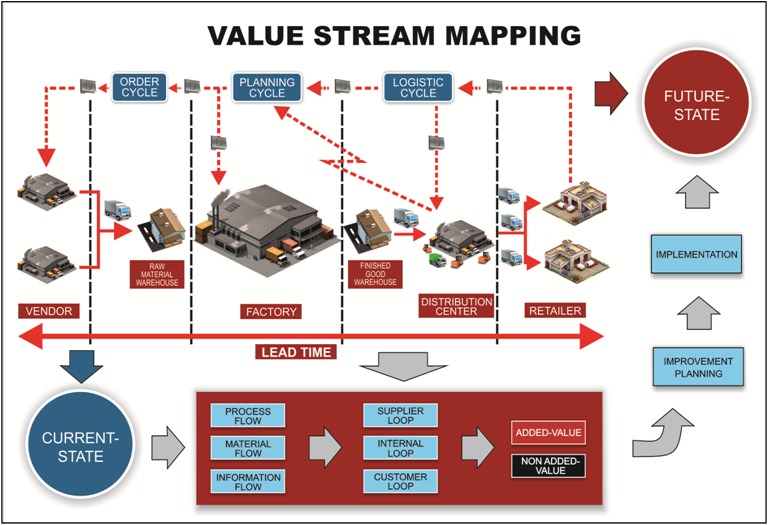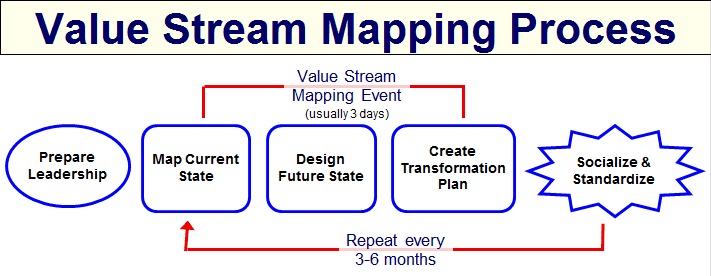Using VSM In Improving Your Business Model
Introduction
Achieving optimal manufacturing efficiency requires balancing time, money, and quality. While achieving 100% efficiency may remain elusive, we can improve continuously. Among the countless paths available, Value Stream Mapping (VSM) stands out as a scientific approach for manufacturing and/or service industries.
By systematically analyzing and optimizing the entire value stream, VSM effectively tackles the difficult challenges encompassing manufacturing, services and supply chain operations across various domains.
ARROWHEAD lean six sigma consulting offers Value Stream Mapping in Mumbai. With our 22+ years expertise in conducting VSMs, we offer comprehensive assistance in analyzing and streamlining value streams, identifying areas for improvement, and implementing practical solutions to maximize operational effectiveness.

Why is VSM (Value Stream Mapping) called the first step in the lean six sigma journey?
The primary goal of implementing value stream mapping six sigma is to enhance the effectiveness and efficiency of various organizational processes. This is achieved by targeting all nonvalue added activities and eliminating lean waste, such as prolonged lead times, defects, material and information flow bottlenecks. One powerful tool to aid this situation is ‘Value Stream Mapping.’
Value stream mapping technique shows how information and materials move within an organization visually. It aims to identify, illustrate, and minimize lean waste while promoting smooth and efficient flow across all manufacturing processes.
Every step in creating a product, from sourcing raw materials to delivering the finished goods to customers, is systematically examined by applying Value Stream Mapping. This approach includes both value-added activities and non-value-added processes, ensuring a thorough understanding of the entire value stream.
Through the application of ARROWHEAD Value Stream Mapping, organizations can effectively identify and address areas of improvement, streamlining their operations and ultimately delivering a superior product to their customers. All of this leads to significant reduction in total turn around time which thereby adds capacity to existing infrastructure without additional cost.
ARROWHEAD
In every VSM, ARROWHEAD Consulting starts by distinctly identifying all areas where processes from order entry through delivery that include repeating stages, especially ones with multiple handoffs, may be streamlined, optimized, removed, or enhanced. Manufacturing handoffs are simpler to visualize since they frequently involve passing particular deliverables around the site. In case of Service sector, the handoffs are mainly in form of information or data.
Let’s know the roots – History of VSM
Value stream mapping has been around for quite a while, even though it’s only recently been adopted by a lot of industries. Mike Rother defines Value Stream Mapping as a lean technique known within Toyota as “Material and Information Flow” mapping in the introduction of the book ‘Learning to See.’ However, previous versions of this lean six sigma tool may be found in the 1918 book ‘Installing Efficiency Methods.’
Value stream mapping in lean manufacturing also grew in popularity as its practices developed in America. Its popularity spread to marketing, IT management, and software development. The phrase “value stream” was initially mentioned in the 1990 book named ‘The Machine That Changed the World’ written by James Womack, Daniel Jones, and Daniel Roos. The same authors’ book Lean Thinking helped to popularise the concept further. They described the value stream as the sequence of tasks an organization does to fulfill a client request.

Two Types of Value Stream Mapping
Enterprise Value Stream Mapping
An enterprise value stream is more broadly defined and specified at a higher level than a product value stream. It includes support, leadership, executive processes, and those involved in the product life cycle. It depicts the interactions between the organization and its external environment and the overall hierarchy of the major internal business operations. The enterprise’s business case is built around the enterprise value stream.
Extended Value Stream Mapping
The traditional version of classic Value Stream Mapping (VSM) is Extended Value Stream Mapping (EVSM), which broadens the reach of VSM beyond the borders of a single organization. EVSM incorporates the end-to-end value chain, including suppliers, consumers, and even customers especially in case of an organization focused on collections as one of their important areas of focus, whereas VSM primarily focuses on mapping the value stream within a particular organization.
Using extended value-stream mapping proves to be a valuable approach in tracking every crucial aspect of the product delivery, involving the entire process from providing raw materials to final delivery to the end consumer and including collecting your money for the order to be officially closed.
How are different industries practicing Value Stream Mapping?
Value stream mapping in project management is used in various industries, including manufacturing and non-manufacturing sectors.
VSM is widely used in manufacturing to evaluate and improve the flow of materials, information, and processes involved in creating commodities. VSM helps identify and remove waste, optimize processes, and improve overall efficiency by visually depicting the value chain from acquiring raw materials through the delivery of completed goods.
Although VSM has traditionally been connected to the manufacturing sector, its ideas, and methodologies have also been shown to be helpful in non-manufacturing sectors. Services such as healthcare, banking, logistics, software development, online retail, education services and marketing are included in these industries.

Benefits of Value Stream Mapping
1. Identify the ratio of Value versus Non-Value added time in current state.
By identifying the value streams within your company, you can establish clear guidelines for your team, simplifying task delegation and ensuring that everyone understands their respective responsibilities in their roles.
2. Identify all 8 lean wastes and their root-causes
Overproduction, downtime, transportation, excess inventory, motion, defects, overprocessing, and unused talent by delving into the root causes of these wastes, organizations can implement targeted solutions to improve efficiency and eliminate non-value-added activities.
3. Build solutions to minimize non-value-added time and activities
It is essential to construct targeted solutions to minimize non-value-added time and activities within processes to enhance productivity and efficiency. Implementing these solutions ultimately delivers greater customer value and improves overall business performance.
4. Create a future state with improved cross-functional collaboration
Concentrating on your value streams will make adopting a continuous improvement mindset easier. By doing so, you can encourage department and team collaboration while streamlining your workflows
5. Significantly improve end-product quality, reduce lead time and cost of process
Focusing on your value streams will help you increase the quality of your present offers in addition to speeding up production. Analyzing your product or service portfolio and paying attention to consumer feedback can help you better understand the demands of your customers.
We provide Lean Six Sigma consulting services for short- and long-term project work and Lean Six Sigma training courses that an esteemed US-based organization has approved.





